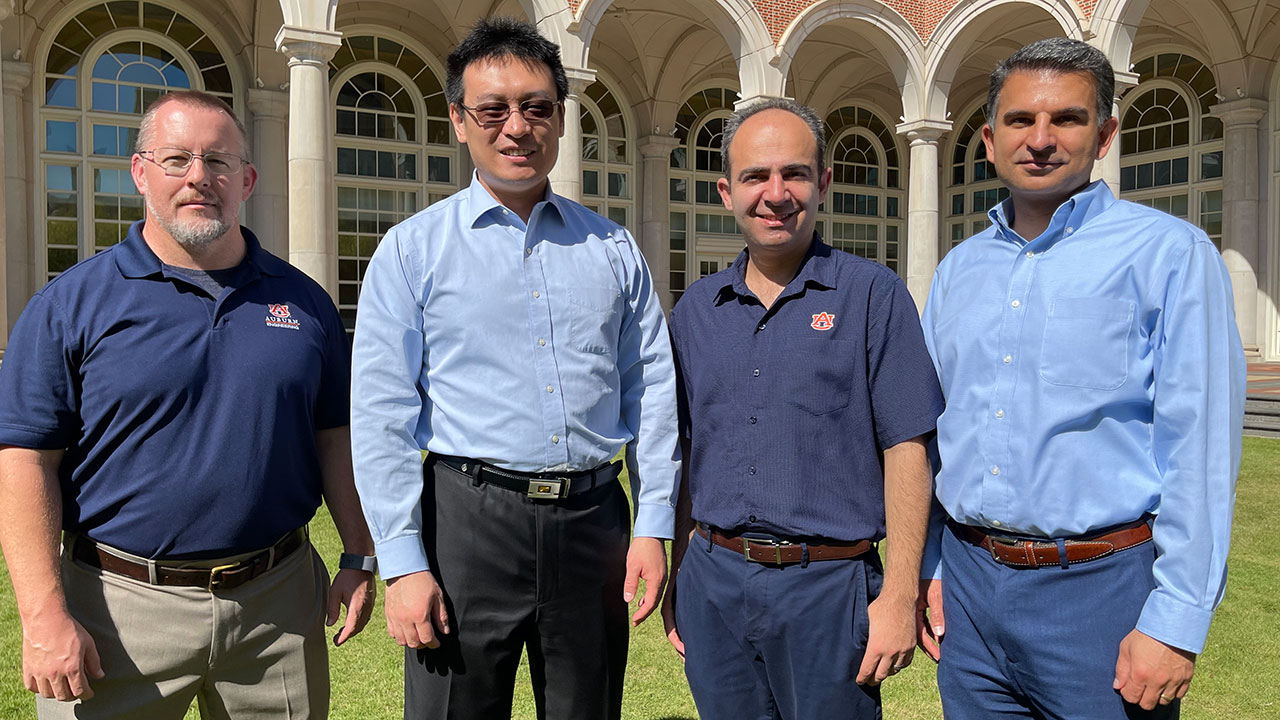Interdisciplinary research team receives NSF grant to develop waste-reducing, biodegradable paper electronics
Current electronics and electronics device printing technologies rely on wet processes such as screen or inkjet printing that require extensive development of inks or solutions with limited sources of functional materials. These inks are often impure, incompatible with biodegradable paper substrates, and printed on eco-unfriendly plastics leading to a huge amount of electronic waste (or E-waste).
Masoud Mahjouri-Samani, the principal investigator and assistant professor in electrical and computer engineering, and a team of scientists representing multi-disciplinary units and centers from Auburn University were awarded a $499,940 grant by the National Science Foundation for their project, “Multi-material Manufacturing of Eco-Friendly and Biodegradable Paper-Based Flexible Hybrid Electronics.”
Co-principal investigators are Shuai Shao, associate professor in mechanical engineering, Nima Shamsaei, Philpott-WestPoint Stevens Distinguished Professor in mechanical engineering and Director of the National Center for Additive Manufacturing Excellence (NCAME), and Michael C. Hamilton, James B. Davis Professor in electrical and computer engineering and director of the Alabama Micro/Nano Science and Technology Center (AMNSTC).
“The team’s extensive expertise in theory and computation, additive manufacturing, mechanical reliability, and micro/nanoelectronics, not only guarantees the success of this research but also opens up a new opportunity for future collaborative activities,” said Shao.
Hamilton believes the infrastructure is well suited for such research activities. “The AMNSTC provides valuable scientific and technical expertise as well as international visibility to this work,” he added. “AMNSTC also provides access to a wide variety of electronic device fabrication and characterization instrumentation that allows us to test the functionality of our printed devices.”
“We are definitely excited about this interdisciplinary research activity among the NCAME, AMNSTC, as well as the departments of Electrical and Computer Engineering and Mechanical Engineering at Auburn University,” said Shamsaei. “At NCAME, most of our capabilities lie in fabricating metallic materials with micro-level accuracy. This research is not only a new addition to the center’s activity and field of additive manufacturing but also can potentially grow into a new field of Functional Additive Nanomanufacturing here at Auburn.”
The team’s research demonstrates a transformative dry additive nanomanufacturing approach that enables the printing of eco-friendly papertronics. Currently, substrates in use are made of polymers, which never decompose.
“What are you going to do with those products, many of which are designed for specific short-term tasks such as smart package labeling and sensors, once you have used them?” Mahjouri-Samani asked. “Throw them away, right? But, again, they don’t decompose. They aren’t biodegradable because they aren’t printed on biodegradable substrates such as paper. We can help prevent a huge waste problem.”
How can electronics and sensors be printed on biodegradable papers? The team has that answer, too.
“We have designed and developed the first printer in the world that can print on any substrate,” said Mahjouri-Samani, who dubbed this creation an “additive nanomanufacturing printer.”
This printing method is based on what he deems an “in-situ and on-demand” generation of nanoparticles by pulsed laser ablation of target materials at atmospheric pressure and at room temperature. These nanoparticles flow out of a nozzle creating a stream of nanoparticles. A substrate is then placed under the nozzle on a programmable X-Y-Z stage where these nanoparticles can be laser sintered (compacted into a solid mass) and crystallized in real-time to form desired patterns and devices.
“Overall, our additive nanomanufacturing process is capable of printing a wide range of dry, contamination-free, multi-layered, and intrinsically pure structures,” he added. “This approach also offers the flexibility of printing onto different types of substrates, including metals, ceramics, plastics, paper and flexible substrates such as thermoplastic polymers.”
Mahjouri-Samani said the primary purpose of this research effort is “to make a positive impact on humanity. We want planet Earth to be as clean as possible for this generation, and generations to follow,” he added. “If we can develop another way to reduce waste, then we are making a positive difference.”
Media Contact: Joe McAdory, jem0040@auburn.edu, 334.844.3447
BY JOE McADORY

From the left: Michael C. Hamilton, Shuai Shao, Masoud Mahjouri-Samani and Nima Shamsaei.
Categories: Engineering, Manufacturing, Advanced Systems
Back to Articles




